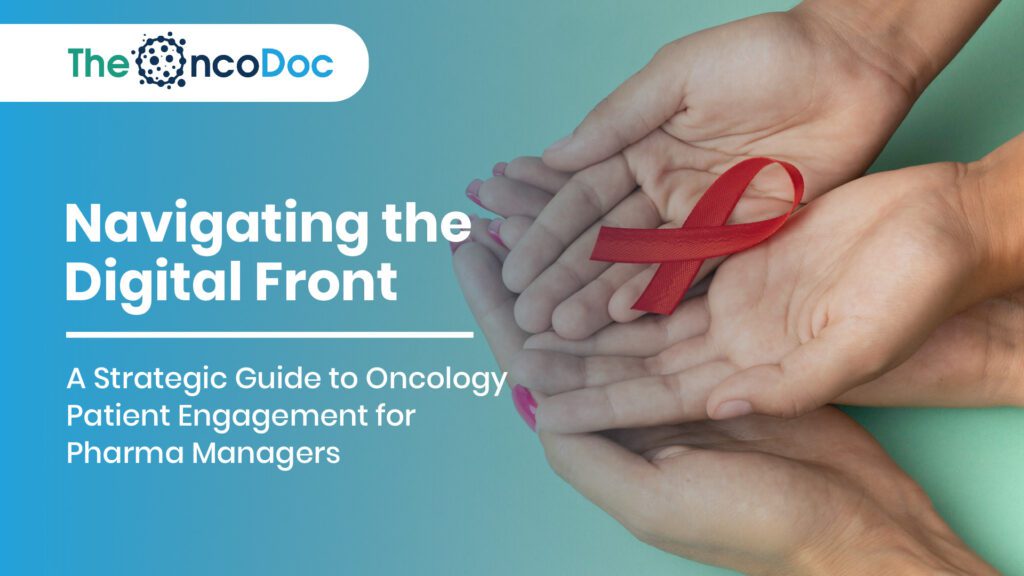Abstract
As the market becomes increasingly competitive, understanding and leveraging digital marketing analytics to drive meaningful patient engagement is no longer a luxury; it is a strategic imperative. This article provides an educational overview for doctors and pharmaceutical managers, delving into the key digital strategies, tools, and analytical frameworks that define success in modern oncology. We examine how leading competitors are evolving beyond traditional outreach, leveraging patient-centric content, social media, and advanced data analytics to foster trust, enhance patient outcomes, and ultimately, solidify their market position. By examining successful approaches and the underlying data, this article aims to equip managers with the insights needed to develop effective, high-quality, and empathetic engagement strategies that resonate deeply with patients and providers alike, while providing a clear roadmap for achieving a competitive advantage in this vital field.
Introduction: The Dawn of the Digitally Empowered Oncology Patient
The traditional model of oncology care, once a largely unidirectional flow of information from physician to patient, has been fundamentally disrupted. Today’s oncology patient is a digitally empowered consumer of health information, actively seeking knowledge, support, and community online from the moment of their diagnosis. They navigate a complex web of information, from clinical trial data and treatment options to personal blogs and social support groups. For pharmaceutical companies, this shift represents a monumental opportunity and a significant challenge. The companies that are succeeding are those that have recognized this change and are actively competing in the digital space, not just for a patient’s attention, but for their trust and engagement.
This article dissects the digital strategies and analytical approaches that are separating market leaders from followers. We will examine the core components of a successful digital patient engagement strategy, highlighting how competitors are leveraging technology to build a more human-centered and effective relationship with patients. We will also provide a data-driven perspective, using a series of illustrative charts and diagrams to reflect the analytics that guide these decisions.
The Evolving Oncology Patient Journey: A Multi-Channel Marathon
The oncology patient journey is a marathon, not a sprint, and it is punctuated by critical digital touchpoints. From the initial moment of suspicion to long-term survivorship, patients turn to digital resources to inform their decisions and cope with the emotional and logistical challenges of their diagnosis. Competitors are excelling by meticulously mapping this journey and creating a seamless, supportive digital ecosystem at every stage.
The digital patient journey can be visualized in the following flowchart, which outlines the key phases and corresponding digital touchpoints that companies are targeting:
- Initial Awareness & Symptom Recognition: The journey often begins with an online search for symptoms. The goal for pharma companies at this stage is not to diagnose, but to provide credible, reliable information that can help patients understand their symptoms and encourage them to seek professional medical advice. Competitors are heavily investing in search engine optimization (SEO) for high-ranking content and developing unbranded educational websites that serve as trusted entry points.
- Diagnosis & Information Gathering: Once a diagnosis is received, the search intensifies. Patients are overwhelmed with new terminology and treatment options. At this stage, leading pharma companies offer patient-friendly websites that simplify complex medical information, telehealth consultations to connect patients with specialists, and access to digital medical records through secure portals. The focus is on providing clarity and reducing anxiety through accessible, well-structured information.
- Treatment Planning & Decision Making: This is a pivotal phase where patients, often with their families, make critical decisions about their care. Digital tools are being deployed to facilitate shared decision-making. Virtual tumor boards, online platforms that allow patients to compare treatment options, and shared decision-making aids are becoming standard offerings. These resources empower patients to have more informed conversations with their oncologists.
- Active Treatment Phase: During active treatment, the focus shifts to support and adherence. Companies are developing a suite of digital tools designed to help patients manage their treatment regimen. This includes remote monitoring apps that track symptoms and side effects, medication adherence reminders, and access to curated online support groups and forums. These tools not only improve patient outcomes but also provide valuable real-world data for companies.
- Post-Treatment Support & Survivorship: The journey doesn’t end with treatment. Long-term survivorship presents its own unique challenges. Competitors are extending their digital support with services like tele-rehabilitation, digital care plans for long-term health management, and follow-up platforms. This continuous engagement helps build lasting loyalty and provides ongoing support for a patient population that may face late-stage side effects or recurrence concerns.
The Power of Digital Marketing Channels: A Strategic Mix
To successfully navigate this patient journey, pharma companies are deploying a sophisticated, multi-channel digital marketing strategy. The effectiveness of these channels varies, and a balanced approach is key. The following bar chart illustrates the relative effectiveness of various digital marketing channels in driving oncology patient engagement, based on hypothetical data:
- Social Media: Social platforms are highly effective for building communities and fostering a sense of connection. Competitors use platforms to host live Q&A sessions with experts, share inspiring patient testimonials (with consent), and create dedicated online support groups. This channel is uniquely powerful for building a sense of trust and empathy.
- Online Support Forums: These patient-led forums are a critical resource for peer-to-peer support. Companies are either creating and moderating their own forums or actively listening to conversations in external ones to understand patient needs and concerns, which in turn informs their content strategy.
- Telehealth Platforms: The rapid adoption of telehealth has made healthcare more accessible and convenient, leading to high levels of patient engagement. By integrating telehealth directly into their digital offerings, companies can provide a seamless experience that connects patients with professionals and information.
- Content Marketing & SEO: High-quality, educational content—such as articles, videos, and infographics—is the bedrock of any successful digital strategy. Competitors are publishing content that simplifies complex medical topics and addresses common patient concerns. By optimizing this content for search engines (SEO), they ensure that patients can find the information they need precisely when they are searching for it, establishing the company as a trusted authority.
- Email Marketing: While a more traditional digital channel, email remains highly effective for personalized communication. Companies use it to send targeted information based on a patient’s specific condition, appointment reminders, and invitations to virtual events, thereby maintaining a consistent and personalized line of communication.
These channels are most powerful when they are not siloed but are instead used in an integrated manner. This is best illustrated by the following Venn diagram, which shows the synergy between key channels:
The overlap between Content Marketing, Social Media, and SEO demonstrates that the most effective strategies leverage all three. Shareable educational resources (content) are promoted on social media and optimized for search (SEO), creating a virtuous cycle of discovery and engagement.
Analytics: The Engine of Patient Engagement and Competitive Advantage
A beautiful website and a great social media presence are meaningless without the data to back them up. To remain competitive, pharma managers must move beyond a “one-size-fits-all” approach and embrace sophisticated analytics. This data provides the crucial insights to understand what’s working, what’s not, and how to allocate resources effectively.
The following pie chart shows a typical budget allocation for a pharma company’s digital marketing efforts in oncology, reflecting the importance of different components:
- Content Creation: With 45% of the budget, content creation is clearly the highest priority. This investment funds the development of high-quality articles, videos, and educational materials that are the foundation of patient engagement.
- Paid Advertising: At 35%, paid advertising is a critical tool for driving traffic to specific resources and campaigns, especially when launching new initiatives or targeting specific patient populations.
- Social Media Management: The 20% allocated here covers the cost of community management, content promotion, and social listening, all of which are essential for building a genuine and responsive relationship with patients.
This investment is paying off. The impact of these digital strategies is evident in the overall growth of patient engagement, as seen in this line chart:
This chart indicates a steady and significant increase in patient engagement over time, reflecting the growing adoption of digital tools and the success of patient-centric marketing campaigns. This upward trend is a clear signal that a well-executed digital strategy yields tangible results.
The Future of Oncology Patient Engagement
The digital landscape is constantly evolving, and the future of oncology patient engagement will be defined by several key trends.
- AI and Personalization: Artificial intelligence and machine learning are being used to analyze patient behavior and personalize content delivery at an unprecedented scale. This ensures that patients receive the most relevant information at the right time, whether it’s a personalized medication reminder, an invitation to a virtual support group based on their specific cancer type, or a recommendation for a relevant blog post.
- Real-World Evidence (RWE): Digital engagement provides a rich source of real-world evidence. By analyzing data from patient apps, online forums, and wearable devices, pharma companies can gain valuable insights into treatment adherence, symptom management, and quality of life, which can inform future drug development and support services.
- Integrated Digital Ecosystems: The future will see a seamless integration of all digital touchpoints. A patient will be able to move effortlessly from an unbranded educational website to a personalized patient portal to a virtual consultation with a healthcare professional, all within a single, cohesive digital ecosystem.
Conclusion
The digital revolution in oncology is not a passing trend; it is the new normal. For pharma managers, the competitive battlefield is no longer confined to the clinic; it is everywhere the patient is looking for information and support. The leaders in this space are those who have embraced a patient-centric, data-driven approach, leveraging high-quality content, a mix of effective digital channels, and sophisticated analytics to build trust and deliver a superior patient experience. By focusing on a compassionate and comprehensive digital strategy, companies can not only drive patient engagement but also play a meaningful role in improving health outcomes and solidifying their position as an indispensable partner in the oncology community.
The Oncodoc team is a group of passionate healthcare and marketing professionals dedicated to delivering accurate, engaging, and impactful content. With expertise across medical research, digital strategy, and clinical communication, the team focuses on empowering healthcare professionals and patients alike. Through evidence-based insights and innovative storytelling, Hidoc aims to bridge the gap between medicine and digital engagement, promoting wellness and informed decision-making.



